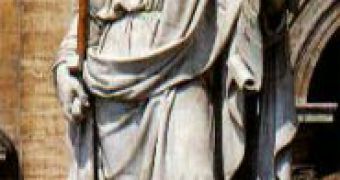Archaeologists have unearthed a stone sarcophagus believed to contain the remains of the Apostle Paul beneath Rome's second largest basilica, St Paul Outside-the-Walls (the first is St Peter).
The remains were hidden under an altar for almost 200 years. "I have no doubt that this is the tomb of St Paul, as revered by Christians in the fourth century," said Giorgio Filippi, the Vatican archaeologist who made the discovery. "Our objective was to bring the remains of the tomb back to light for devotional reasons, so that it could be venerated and be visible," said Filippi.
The interior of the sarcophagus has not yet been investigated. The sarcophagus was found after five years of extensive excavations at the church. The decision to unearth the sarcophagus was made after many pilgrims who came to Rome during the Catholic Church's 2000 Jubilee year expressed disappointment as the saint's tomb could not be visited or touched. "We wanted to bring it to the light for devotional reasons so it can be venerated," said Dr Filippi.
The sarcophagus dates from AD390, when the Emperor Theodosius "saved" the remains and moved them to the site, near the Appian Way. Two churches were successively built over the place where tradition said the saint had been buried. The second church, St Paul Outside-the-Walls, built by the Roman emperor Theodosius in the fourth century, left the tomb visible, first above ground and later in a crypt.
The church has been rebuilt several times since then, most recently in 1823, following a devastating fire, and the ancient crypt was filled with earth and covered by a new altar. The archaeologists descended into a series of tunnels and chambers from the fourth century and discovered a marble plaque inscribed with "Paul the Apostle, Martyr".
St Paul's relics were underneath a stone slab with three holes to allow visitors to push pieces of material through and touch the saint's remains. The cloth would then be imbued with the sanctity within.
St Paul was born in Tarsus (in today Turkish Mediterranean coast), shortly after Jesus. He was one of the Christian Church's most important leaders and the presumed author of much of the New Testament. A Jewish, originally named Saul, was converted by him to Christianity on the road to Damascus. He was arrested in Jerusalem for being Christian and imprisoned in Rome. The legend says he was beheaded in the city around AD64. The head does not rest with the rest of the remains, but it is supposed to be located inside a silver bust at the St John Lateran church on the Celian hill.

 14 DAY TRIAL //
14 DAY TRIAL //